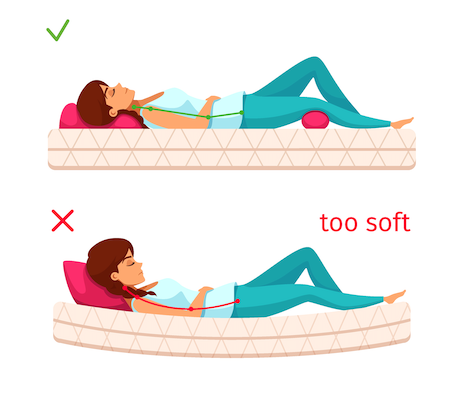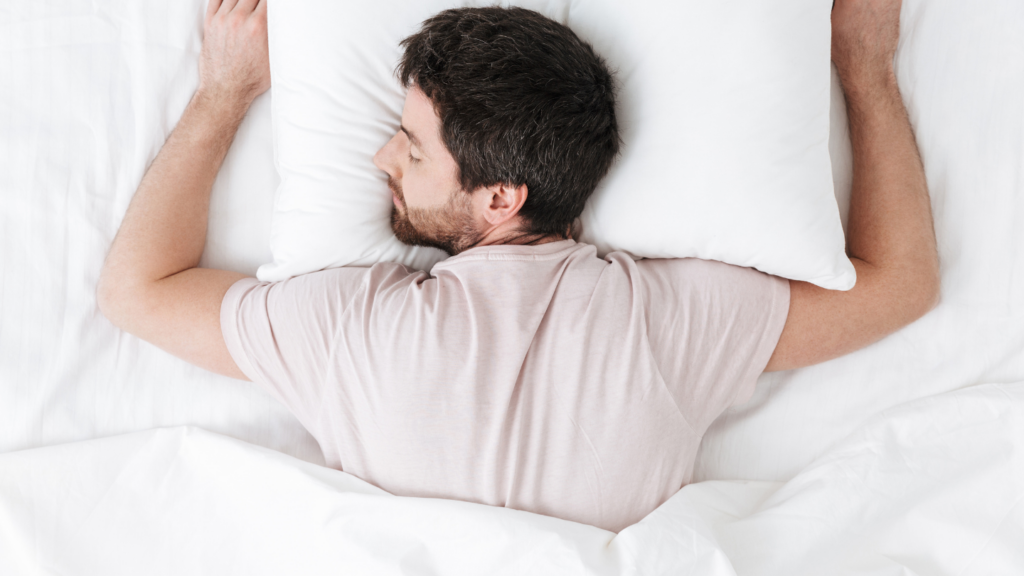Back pain is a prevalent issue that affects millions of people around the world. It can range from mild discomfort to chronic agony, impacting not only physical health but also overall well-being. One often overlooked aspect that can significantly influence back pain is sleep position.
The way you sleep plays a crucial role in determining the quality of rest you get and the strain your spine experiences during the night. In this article, we will delve into the importance of sleep positions for back pain relief and explore the best sleeping positions to alleviate such discomfort.
The Importance of Sleep Position for Back Pain
Sleeping is not just a time to rest; it’s a period of recovery and healing for the body. The sleep position you choose can either aid this process or exacerbate existing back issues. The spine’s alignment during sleep is pivotal, as it impacts the pressure on different areas of your back.
How Your Sleep Position Can Affect Back Pain
The relationship between sleep position and back pain is closely intertwined. When you sleep in a position that doesn’t support the natural curvature of your spine, you risk straining muscles and joints. Moreover, poor sleep positions can even contribute to long-term spinal misalignment. By choosing the right sleep position, you can alleviate pressure on your back, promote better circulation, and reduce the likelihood of pain.
The Connection Between Sleep and Spinal Health
Maintaining the spine’s natural alignment is paramount for managing or preventing back pain. The spine has three natural curves: the cervical (neck) curve, the thoracic (upper back) curve, and the lumbar (lower back) curve. These curves help distribute the body’s weight evenly and maintain a balanced posture.
Best Sleep Positions for Back Pain Relief
Getting a good night’s sleep is essential for overall well-being, and for individuals dealing with back pain, finding the right sleep position can be a game-changer. The way we position our bodies during sleep can either alleviate or worsen back pain.
Here are some of the best sleep positions for back pain relief:
Sleeping on Your Back
Sleeping on your back, also known as the supine position, is generally considered one of the best positions for back pain relief. When you sleep on your back, your spine remains relatively neutral, and your body weight is evenly distributed. This position minimises pressure points and reduces strain on the spine, making it beneficial for individuals with lower back pain.
Using Proper Pillow Support
To enhance the benefits of back sleeping, it’s crucial to use proper pillow support. Placing a pillow under your knees helps maintain the natural curve of your lower back and reduces stress on your spine. Additionally, using a supportive pillow for your head and neck is essential for preventing any strain in those areas.
The Benefits of Sleeping Supine
Sleeping supine not only helps with back pain but also offers other health benefits. It can reduce the risk of acid reflux since your head is elevated, aiding digestion. However, for some individuals, sleeping on their back might lead to snoring or aggravate existing sleep apnea symptoms. In such cases, it’s essential to find a balance between back sleeping and the individual’s specific needs.
Sleeping on Your Side
Side sleeping is another recommended position for back pain relief, particularly for those with pain in the upper back or hips. When sleeping on your side, it’s important to keep your spine aligned. Placing a pillow between your knees can help maintain proper alignment and reduce strain on your hips and lower back.
Pillow Placement for Side Sleepers
For side sleepers, the choice of pillow is crucial. A pillow that adequately supports the head and neck without tilting them upward or downward is ideal. This helps keep the spine in a neutral position and prevents unnecessary pressure on the neck and shoulders.
Why Side Sleeping Works
Side sleeping works well for back pain relief because it allows the spine to elongate. This position reduces the likelihood of the lower back arching excessively, which can lead to discomfort. Additionally, side sleeping can open up the airways and reduce snoring, making it beneficial for individuals with sleep-related breathing issues.
The Fetal Position: A Variant of Side Sleeping
The fetal position involves sleeping curled up on your side, resembling the position of a fetus in the womb. While this position can provide comfort to some, it might not be suitable for everyone, especially if you tend to curl up tightly. It’s important to ensure that your back remains straight, and your knees are not drawn too far up toward your chest.
When Fetal Position is Best
The fetal position can be particularly useful for individuals with herniated discs. Curling up can help open up the space between vertebrae and reduce pressure on spinal discs. However, maintaining proper alignment is essential to reap the benefits of this position.
Sleeping on Your Stomach
Sleeping on your stomach, also known as the prone position, is generally considered the least favorable for back pain relief. This position often leads to the arching of the lower back and straining of the neck, which can exacerbate existing pain.
The Challenges of Stomach Sleeping
Stomach sleeping can force your neck to remain turned to the side for extended periods, leading to neck pain and stiffness. Additionally, the spine’s natural curves are not adequately supported in this position, potentially leading to discomfort and long-term issues.
Modifications for Stomach Sleepers
If you’re a dedicated stomach sleeper, there are ways to make this position less harmful to your back. Placing a pillow under your hips can help alleviate some pressure on the lower back. However, it’s important to note that even with modifications, stomach sleeping might not be the best choice for back pain sufferers.
Pillow and Mattress Selection for Back Pain Relief
Sleeping with back pain can be a nightly struggle, affecting not only the quality of sleep but also overall well-being. The way we position our bodies during sleep can significantly impact the level of discomfort or relief we experience.
While there is no one-size-fits-all solution, understanding the best sleep positions for different types of back pain and making informed choices regarding pillows and mattresses can greatly contribute to a restful night’s sleep. In this article, we explore the connection between sleep positions and back pain relief, offering valuable insights into selecting the right pillow and mattress, along with additional tips for improving sleep quality.
Choosing the Right Pillow for Your Sleep Position
A critical yet often underestimated factor in achieving back pain relief is the pillow we use. The choice of pillow can influence the alignment of the spine and the comfort of the head and neck. When dealing with lower back pain, the selection of an appropriate pillow becomes paramount.
Back sleepers should consider using a thinner pillow to avoid straining the neck and spine. This assists in maintaining the natural curvature of the spine, which is essential for reducing lower back pain. On the other hand, side sleepers might find more comfort with a slightly thicker pillow to adequately fill the space between the neck and the mattress, promoting proper spinal alignment.
The Role of Mattress Firmness in Back Pain Relief
Undoubtedly, the mattress we sleep on has a significant impact on back pain and sleep quality. Mattress firmness is a crucial factor to consider when aiming for back pain relief. A mattress that is either too soft or too firm can lead to improper spinal alignment, exacerbating back pain. Individuals with lower back pain generally benefit from a medium-firm mattress.
This type of mattress offers a balance between support and comfort, providing adequate spinal alignment while cushioning pressure points. However, personal preferences can play a role; some individuals might find more relief with a slightly softer or firmer mattress. It’s essential to test different options to discover the firmness level that works best for one’s specific needs.
Additional Tips for Back Pain-Free Sleep
While adjusting your sleep position is a significant step towards alleviating back pain, several additional strategies can enhance your sleep quality and overall well-being. Incorporating these practices into your bedtime routine can contribute to a more restful and pain-free night’s sleep:
Stretching and Relaxation Techniques Before Bed
Preparing the body for sleep goes beyond just finding the right pillow and mattress. Incorporating gentle stretching and relaxation techniques into the pre-sleep routine can help alleviate back pain. Engaging in light stretches that target the back, hips, and hamstrings can promote muscle relaxation and flexibility. Practices like yoga or deep breathing exercises can also calm the mind and reduce stress, further enhancing the chances of a peaceful night’s sleep.
Sleep Hygiene Practices for a Better Night’s Rest
Practicing good sleep hygiene is essential for everyone, particularly for those managing back pain. Sleep hygiene involves creating an environment conducive to sleep and establishing consistent sleep patterns. Keeping the bedroom dark, quiet, and at a comfortable temperature contributes to better sleep quality. Additionally, sticking to a regular sleep schedule helps regulate the body’s internal clock, making it easier to fall asleep and wake up naturally.
For Pain Relief
While adjusting sleep positions and optimising sleep environment can go a long way in managing back pain, persistent or severe pain should never be ignored. If back pain disrupts sleep regularly or is accompanied by other concerning symptoms, it’s crucial to seek guidance from a Pain Doctor.
Our Pain Doctor can identify underlying issues and lead to appropriate interventions for effective pain management. Ignoring pain symptoms or attempting to self-diagnose and treat them can lead to unnecessary suffering, worsen your condition, and potentially delay effective treatment.
Adjusting Your Sleep Habits for Back Pain Management
Managing back pain involves not only finding the right sleep position but also adopting healthy sleep habits. These habits can significantly impact your sleep quality and overall comfort. Well, highlighted below are some important sleep habits to consider for effective back pain management:
Consistency in Sleep Schedule
Maintaining a consistent sleep schedule is beneficial not only for overall sleep quality but also for managing back pain. Going to bed and waking up at the same time each day helps regulate the body’s internal clock, enhancing the sleep-wake cycle. This, in turn, can reduce sleep disturbances and minimise the potential for exacerbating back pain.
Creating a Relaxing Bedtime Routine
Establishing a relaxing bedtime routine can signal the body that it’s time to wind down and prepare for sleep. Engaging in calming activities such as reading, listening to soothing music, or taking a warm bath can promote relaxation. Avoiding screens, including phones and computers, before bed is also advisable, as the blue light emitted by these devices can interfere with the production of the sleep hormone melatonin.
The Impact of Diet and Exercise on Sleep and Back Health
Maintaining a healthy lifestyle through balanced nutrition and regular exercise contributes to both overall well-being and back pain management. A nutritious diet supports proper muscle and joint function, while exercise helps strengthen the core muscles that support the spine. However, it’s important to avoid intense exercise close to bedtime, as it can stimulate the body and make it harder to fall asleep.
Conclusion: Improving Your Sleep Position for a Pain-Free Back
In the pursuit of alleviating back pain, this article has shed light on the crucial role sleep positions play in our overall well-being. Exploring the benefits of sleeping on one’s back with proper pillow support, the advantages of side sleeping, and considerations for stomach sleepers, it emphasised the connection between sleep and spinal health.
Beyond sleep positions, the article highlighted the significance of consistent sleep schedules, calming bedtime routines, and seeking medical advice when necessary for comprehensive back pain management. By understanding the impact of sleep posture, selecting suitable pillows and mattresses, and adopting healthy sleep habits, individuals can take proactive steps toward achieving a pain-free back and enhancing their overall quality of life.










